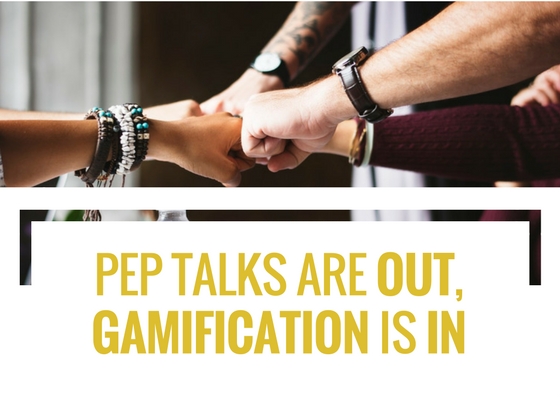10 Reasons Employee Gamification Beats Company Pep Talks

It’s easy to share an inspirational quote or give a motivational pep talk to your employees, but are these tactics really working? They may not be as effective as you think. While some inspiring words can help motivate your employees for a short time, eventually, words fade, and you’re left with workers looking for their next source of motivation.
Why waste your time talking when you can see actual results with gamification in the workplace? Here are 10 reasons gamification is more beneficial in encouraging employees to work harder and achieve results.
1. Goals are Straightforward
In games that everyone loves, the goals and rules are laid out very plainly, making them simple to understand and follow. The same is true with gamification in the office—when done right, there is little room for confusion.
2. Easy Access to Feedback
With gamification, managers and higher ups can see clearly how their employees are doing and can reach out to offer guidance and assistance, making feedback to the employee easy to attain. And because a gamification platform tracks key metrics and tools in real time, feedback is available to your employees either instantaneously, or as soon as integrated data is updated.
3. Positive Experience
Despite its name, gamification isn’t exactly a game. However, it is tailored to make work a more positive experience while they strive to achieve goals and earn recognition. It can, at times, be really fun, too. It’s human nature to want to be around people we like, and to be in an environment that is upbeat and empowering (and fun!). Gamification motivates employees in the workplace to enjoy work together.
4. More Reward and Recognition
Everyone enjoys being recognized for a job well done, and gamification makes rewarding good work easier than ever. Ultimately, this motivates and encourages employees to work harder and produce even better results.
5. Stronger Sense of Camaraderie
There’s nothing like a game to bring people together as they work toward a common goal. Implement gamification in the workplace, and you’ll feel a stronger sense of community and togetherness immediately.
6. Improvement in Performance
People have an innate desire to complete lists and check off tasks. It gives them something to work towards, and a sense of achievement after receiving a reward (even if the reward comes in the form of a “badge” or “achievement”). The true power of gamification doesn’t lie in the ability to turn work into a game; it’s in creating that extra motivation to measurably improve performance across your entire team.
7. Progress is Easier to Track
Many companies struggle with tracking the progress of individuals and teams within their organization. This is something, however, that gamification is excellent at. For example, in any game, the progress of players is tracked, whether it’s on a game board, a scoreboard, or some other creative method. This makes it easier to identify the areas where employees need further guidance and the places where they’re excelling.
With gamification, as long as you’re using the right metrics and data points, you can track progress. With that data, you can create “leaderboards” and rank employees based on their metrics. You can even set individualized “goals” for employees and track their progress as they work to achieve those goals. If they’re falling behind on their journey toward completion, they (and you) will know. And when they go above and beyond, they get credit for it, too.
8. Employees Can See How They Rank
Competition within the office can be somewhat controversial. In some environments, such as in a customer support staff, competition between team members might backfire. That’s because there are too many variables that can breed resentment within your team (after all, when there’s a competition, there’s always a “loser”).
However, when used right, a little friendly competition can be a good thing. It’s recommended that office competitions that are linked to individual performance are kept within small teams, rather than company-wide. That way, employees only compete with other team members who they work with on a regular basis.
Score tracking is another approach that allows team members to see exactly where they rank in relation to other employees. Seeing how they compare to their peers can foster some friendly competition, which is a powerful motivator for a lot of people.
For many organizations, the best competition is when individuals compete with themselves. When employees are given increasingly challenging tasks, and they are rewarded for that extra effort every time, they’ll find that extra motivation from their innate desire to improve themselves.
9. Access to Coaching and Instruction
Without great coaches and instruction, the best athletes would never have found success. Gamification in the workplace gives you the opportunity to:
- Identify who is struggling (and what they’re struggling with) so you can provide extra coaching
- Coach and train your employees in a way the challenges them and stretches their abilities
- Teach new skills while avoiding wasting time teaching skills employees have already mastered
10. It’s Not All Fun and Games – It’s Serious ROI
Who doesn’t like having fun at work? But while gamification has “game” in its name, it’s not all fun and games.
Gamification brings people together, enhancing your workplace culture and making work more rewarding for your employees.
Gamification increases productivity, directly leading to better performance across all teams.
Gamification gives you a measurable return on your investment.
Ultimately, gamification is pretty serious stuff.

